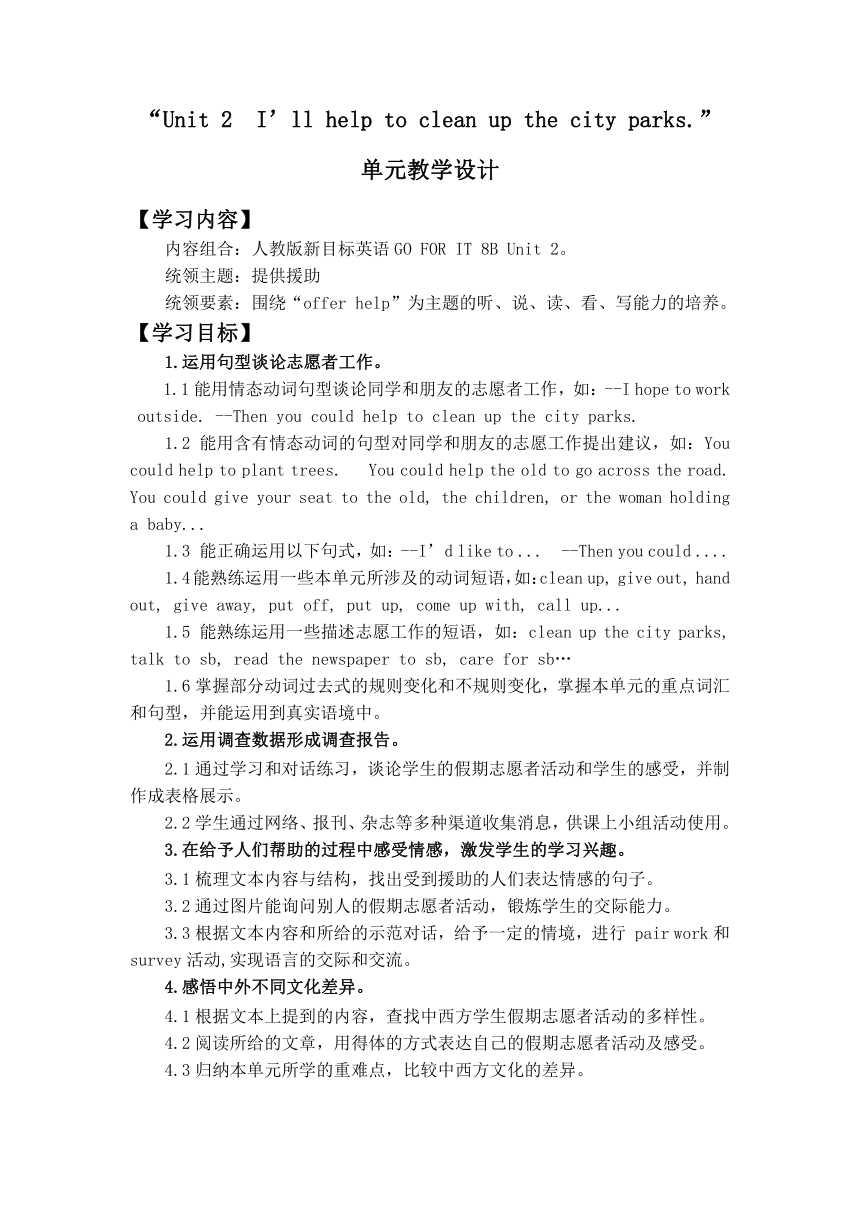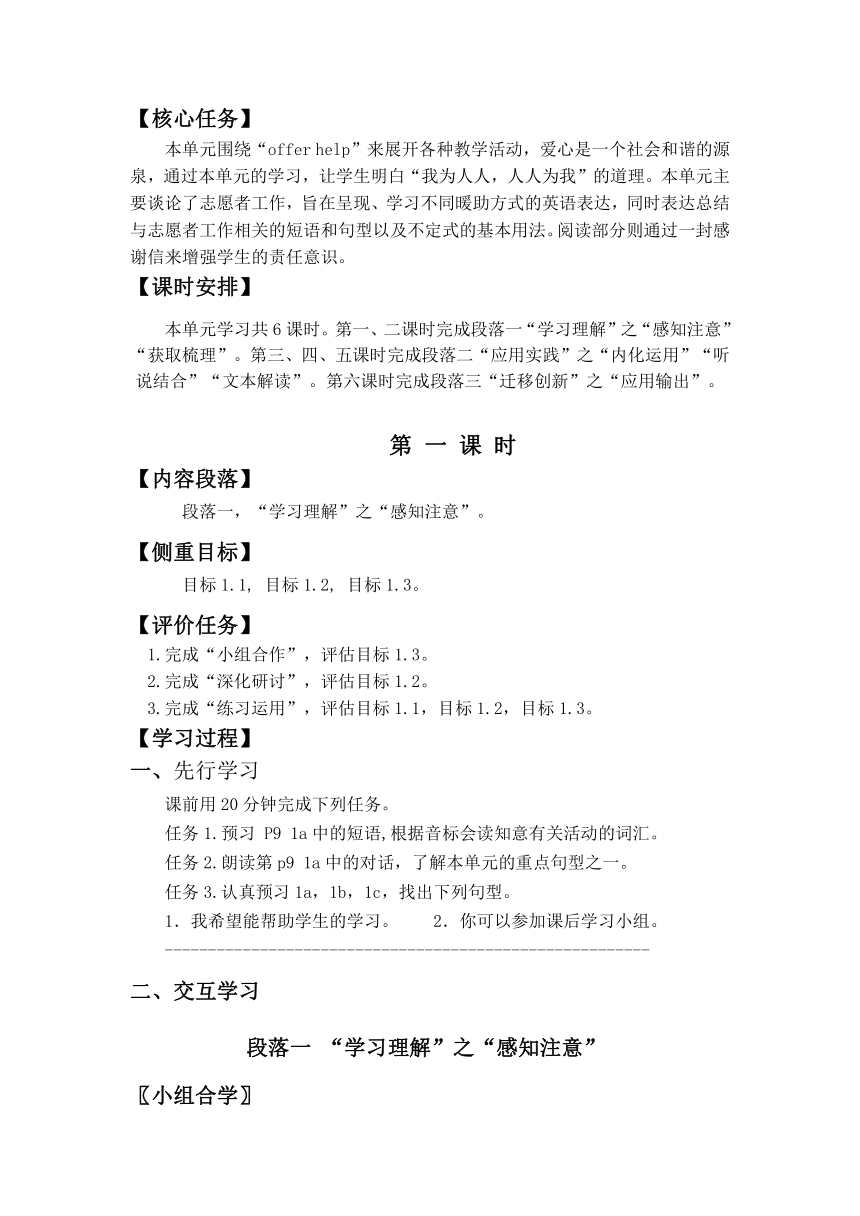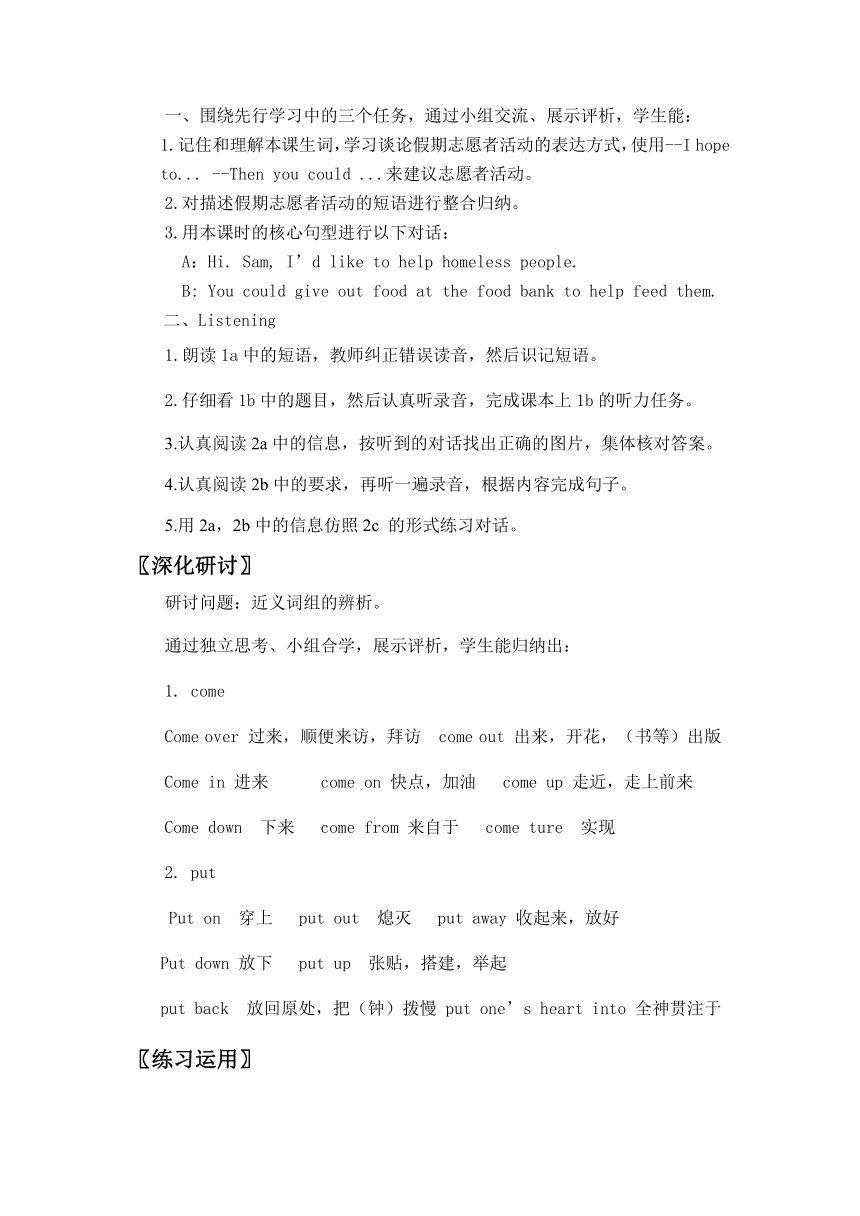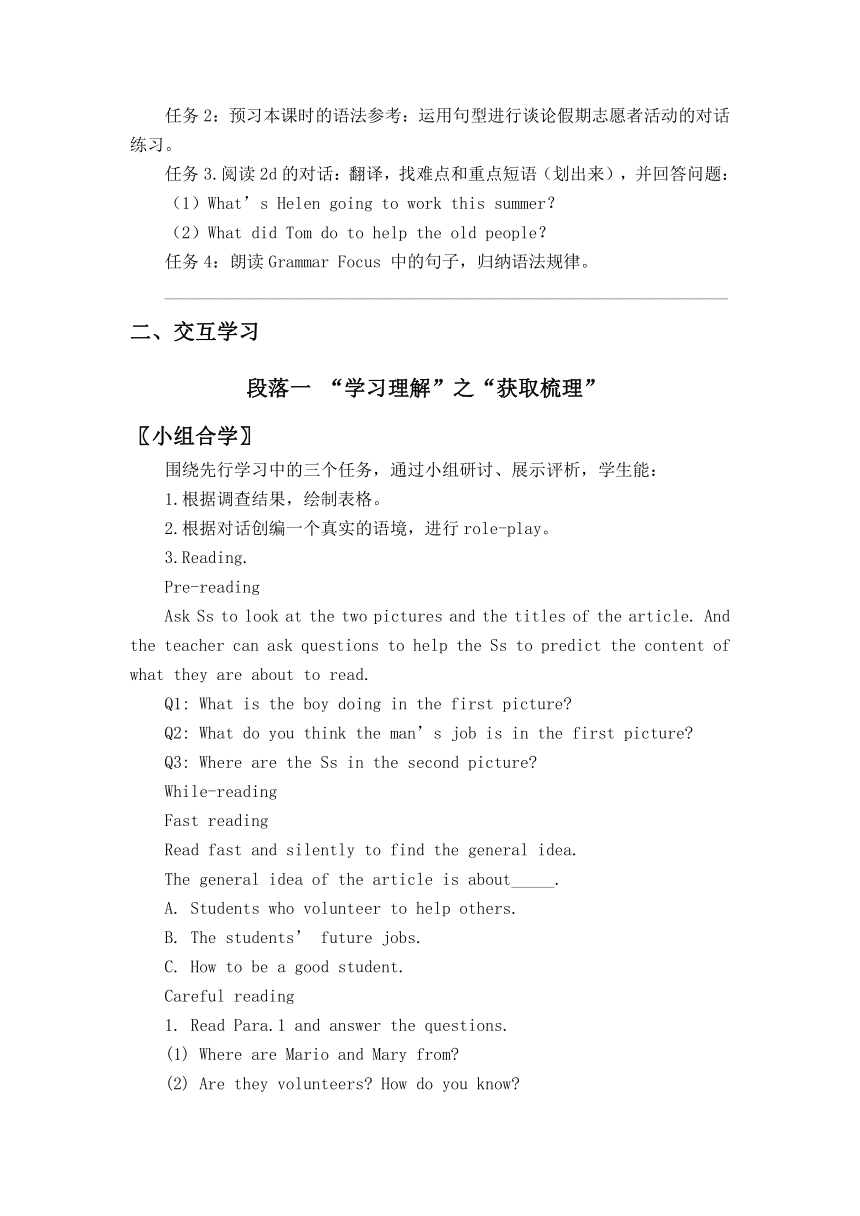Unit 2 I'll help to clean up the city parks. 单元教学设计 2023-2024学年人教版八年级英语下册
文档属性
| 名称 | Unit 2 I'll help to clean up the city parks. 单元教学设计 2023-2024学年人教版八年级英语下册 |  | |
| 格式 | docx | ||
| 文件大小 | 38.1KB | ||
| 资源类型 | 教案 | ||
| 版本资源 | 人教新目标(Go for it)版 | ||
| 科目 | 英语 | ||
| 更新时间 | 2024-01-29 15:19:15 | ||
图片预览





文档简介
“Unit 2 I’ll help to clean up the city parks.”
单元教学设计
【学习内容】
内容组合:人教版新目标英语GO FOR IT 8B Unit 2。
统领主题:提供援助
统领要素:围绕“offer help”为主题的听、说、读、看、写能力的培养。
【学习目标】
1.运用句型谈论志愿者工作。
1.1能用情态动词句型谈论同学和朋友的志愿者工作,如:--I hope to work outside. --Then you could help to clean up the city parks.
1.2 能用含有情态动词的句型对同学和朋友的志愿工作提出建议,如:You could help to plant trees. You could help the old to go across the road. You could give your seat to the old, the children, or the woman holding a baby...
1.3 能正确运用以下句式,如:--I’d like to ... --Then you could ....
1.4能熟练运用一些本单元所涉及的动词短语,如:clean up, give out, hand out, give away, put off, put up, come up with, call up...
1.5 能熟练运用一些描述志愿工作的短语,如:clean up the city parks, talk to sb, read the newspaper to sb, care for sb…
1.6掌握部分动词过去式的规则变化和不规则变化,掌握本单元的重点词汇和句型,并能运用到真实语境中。
2.运用调查数据形成调查报告。
2.1通过学习和对话练习,谈论学生的假期志愿者活动和学生的感受,并制作成表格展示。
2.2学生通过网络、报刊、杂志等多种渠道收集消息,供课上小组活动使用。
3.在给予人们帮助的过程中感受情感,激发学生的学习兴趣。
3.1梳理文本内容与结构,找出受到援助的人们表达情感的句子。
3.2通过图片能询问别人的假期志愿者活动,锻炼学生的交际能力。
3.3根据文本内容和所给的示范对话,给予一定的情境,进行 pair work和 survey活动,实现语言的交际和交流。
4.感悟中外不同文化差异。
4.1根据文本上提到的内容,查找中西方学生假期志愿者活动的多样性。
4.2阅读所给的文章,用得体的方式表达自己的假期志愿者活动及感受。
4.3归纳本单元所学的重难点,比较中西方文化的差异。
【核心任务】
本单元围绕“offer help”来展开各种教学活动,爱心是一个社会和谐的源泉,通过本单元的学习,让学生明白“我为人人,人人为我”的道理。本单元主要谈论了志愿者工作,旨在呈现、学习不同暖助方式的英语表达,同时表达总结与志愿者工作相关的短语和句型以及不定式的基本用法。阅读部分则通过一封感谢信来增强学生的责任意识。
【课时安排】
本单元学习共6课时。第一、二课时完成段落一“学习理解”之“感知注意”“获取梳理”。第三、四、五课时完成段落二“应用实践”之“内化运用”“听说结合”“文本解读”。第六课时完成段落三“迁移创新”之“应用输出”。
第 一 课 时
【内容段落】
段落一,“学习理解”之“感知注意”。
【侧重目标】
目标1.1, 目标1.2, 目标1.3。
【评价任务】
1.完成“小组合作”,评估目标1.3。
2.完成“深化研讨”,评估目标1.2。
3.完成“练习运用”,评估目标1.1,目标1.2,目标1.3。
【学习过程】
一、先行学习
课前用20分钟完成下列任务。
任务1.预习 P9 1a中的短语,根据音标会读知意有关活动的词汇。
任务2.朗读第p9 1a中的对话,了解本单元的重点句型之一。
任务3.认真预习1a,1b,1c,找出下列句型。
1.我希望能帮助学生的学习。 2.你可以参加课后学习小组。
--------------------------------------------------------
二、交互学习
段落一 “学习理解”之“感知注意”
〖小组合学〗
一、围绕先行学习中的三个任务,通过小组交流、展示评析,学生能:
1.记住和理解本课生词,学习谈论假期志愿者活动的表达方式,使用--I hope to... --Then you could ...来建议志愿者活动。
2.对描述假期志愿者活动的短语进行整合归纳。
3.用本课时的核心句型进行以下对话:
A:Hi. Sam, I’d like to help homeless people.
B: You could give out food at the food bank to help feed them.
二、Listening
1.朗读1a中的短语,教师纠正错误读音,然后识记短语。
2.仔细看1b中的题目,然后认真听录音,完成课本上1b的听力任务。
3.认真阅读2a中的信息,按听到的对话找出正确的图片,集体核对答案。
4.认真阅读2b中的要求,再听一遍录音,根据内容完成句子。
5.用2a,2b中的信息仿照2c 的形式练习对话。
〖深化研讨〗
研讨问题:近义词组的辨析。
通过独立思考、小组合学,展示评析,学生能归纳出:
come
Come over 过来,顺便来访,拜访 come out 出来,开花,(书等)出版
Come in 进来 come on 快点,加油 come up 走近,走上前来
Come down 下来 come from 来自于 come ture 实现
put
Put on 穿上 put out 熄灭 put away 收起来,放好
Put down 放下 put up 张贴,搭建,举起
put back 放回原处,把(钟)拨慢 put one’s heart into 全神贯注于
〖练习运用〗
用所给单词的适当形式填空。
There was an ____(argue) happened between Tom and Jack last night.
Lucy is used to_________ (have) a walk after supper every day.
3. The people in Iraq keep fighting for their own ________ (free).
The teenagers have to work hard because of the _________ (press)
from their parents.
5. They tried their best to find the ______ (solve) because they want to solve the problems.
〖学后反思〗
完成导学相对应练习,总结本节课学习的收获,反思存在的问题。
第 二 课 时
【内容段落】
段落一,学习理解”之“获取梳理”。
【侧重目标】
目标1.1,目标1.2, 目标1.3,目标2,目标3.3。
【评价任务】
1.完成“小组合作”,评估目标1.2,目标2。
2.完成“深化研讨”,评估目标1.3,目标3.3。
3.完成“练习运用”,评估目标目标1.1,目标1.3,目标2。
【学习过程】
一、先行学习
用20分钟时间完成以下任务。
任务1:认读并书写本课单词(个人自读,记忆单词.小组互相检查读、写
情况.)
任务2:预习本课时的语法参考:运用句型进行谈论假期志愿者活动的对话练习。
任务3.阅读2d的对话:翻译,找难点和重点短语(划出来),并回答问题:
(1)What’s Helen going to work this summer?
(2)What did Tom do to help the old people?
任务4:朗读Grammar Focus 中的句子,归纳语法规律。
_________________________________________________________________
二、交互学习
段落一 “学习理解”之“获取梳理”
〖小组合学〗
围绕先行学习中的三个任务,通过小组研讨、展示评析,学生能:
1.根据调查结果,绘制表格。
2.根据对话创编一个真实的语境,进行role-play。
3.Reading.
Pre-reading
Ask Ss to look at the two pictures and the titles of the article. And the teacher can ask questions to help the Ss to predict the content of what they are about to read.
Q1: What is the boy doing in the first picture
Q2: What do you think the man’s job is in the first picture
Q3: Where are the Ss in the second picture
While-reading
Fast reading
Read fast and silently to find the general idea.
The general idea of the article is about_____.
Students who volunteer to help others.
The students’ future jobs.
How to be a good student.
Careful reading
Read Para.1 and answer the questions.
Where are Mario and Mary from
Are they volunteers How do you know
Read Para.2 and answer the questions.
What does Mario volunteer to do
Why does he volunteer to do that
How does he feel about volunteering
Read Para.3 and answer.
(1)What does Mary volunteer to do
(2)Why does she volunteer to do that
(3)How does she feel about volunteering
4. After understanding the whole passage, the teacher can ask Ss to finish 3c.
Post reading
Read the passage aloud.
Read and discover the main points.
Talk about what the spirit of volunteering is.
Ask Ss to think about the spirit of volunteering, and when write down what they volunteer to do and why they volunteer to do it.
〖深化研讨〗
研讨问题:so和such的辨析。
通过独立思考、小组合学,学生能归纳其语法特征:
Such + a/an + adj + n单
Such + adj + n复
So + adj/adv
So + adj + a/an + n单
So + many/much/few/little + n
〖练习运用〗
根据首字母或汉语提示完成单词。
一、词汇
1.—She wants to be a __________ (志愿者).
2.—Did you see the poster on the ____ (公告牌) —No, I didn’t.
3.I didn’t have breakfast. Now I have a ____________ (感觉) of hunger.
4.We saw a ____________ (标志) which says “No parking”. So we couldn’t park the car there.
5.They have a strong feeling of ____________ (满足).
6.—When is the tennis __________ (train)
—It is at four o’clock in the afternoon.
7.She had __________ (difficult) finding the way to the museum.
8.He can’t see anything. He is a b________ man.
9.There is something wrong with his ears. He is a d________ man.
10.I can’t go to the movies with you. I have to look after my s________ sister. She has a bad cold.
11.She doesn’t have friends in her new school. So she feels very
l________.
12.My uncle has a large house and he is the o________ of the house.
13.My younger sister looks very sad. Let’s go and c________ her up.
14.I don’t u__________ your meaning. Please say it again.
〖学后反思〗
1.梳理和绘制学习本单元A部分的“offer help”话题思维导图。
2.完成导学作业,总结本节课的学习收获,反思学习中存在的问题。
第 三 课 时
【内容段落】
段落二,“应用实践”之“内化运用”。
【侧重目标】
目标1.2,目标1.3,目标2.2,目标3.2,目标3.3。
【评价任务】
1.完成“小组合作”,评估目标1.2,目标1.3,目标 3.2。
2.完成“深度研学”,评估目标3.3。
3.完成“练习运用”,评估目标2.2。
【学习过程】
先行学习
课前用20分钟时间独立完成以下任务。
任务1:熟读并识记本单元的重点词汇。
任务2. 阅读Grammar Focus,并找出规律。
______________________________________
任务3:继续学习动词不定式的用法。
二、交互学习
段落二 “应用实践”之“内化运用”
〖小组合学〗
围绕先行学习中的三个任务,通过小组合学、展示评析,学生能:
1.Read the sentences aloud in Grammar Focus. And then let the Ss discuss what they should do to help others. Finally, ask some Ss to share their ideas.
2.circle the infinitives and the phrasal verbs.
3.Practice: fill in the blanks in the box.(4a)
4.complete 4b.
5.complete 4c.
〖深化研讨〗
研讨问题:动词不定式用法。
通过独立思考、小组合学,学生能归纳其语法特征:
①作动词宾语。常见的后跟不定式作宾语的动词或词组有would like,want,help,learn,hope,decide,volunteer等。
②作宾语补足语。常见的后跟不定式作宾语补足语的动词有ask,want,
tell,invite等。
③作目的状语。如:You could visit the sick kids to cheer them
up.
④作后置定语。如:Claire missed a great chance to make a lot of
money.
⑤动词help及一些役使动词后面常省略to.
动词短语
put up, hand out, call up, cheer up, come up with, give out,
put off
〖练习运用〗
单选
15.—Tom’s pet dag died last week; he still looks sad now.
—Maybe we should do something to ______ him ______.
A. cheer; up B. cheer; on C. pick; up D. look; out
16.My brother ______ play basketball. But now he likes playing baseball.
A. used to B. is used to C. is used for D. was used to
17.—How do you know the store wants shop assistants
—It ______ many signs in the neighborhood.
A. put down B. put on C. put out D. put up
18.Tom, Your room is too dirty. You must ______.
A. clean up it B. clean up them C. clean them up D. clean it up
19.My grandparents’ clock doesn’t work. I’m trying to find a repairman who can ______ for them.
A. fix it up B. fix up it C. put up it D. put it up
10.—Never ___ today’s work till tomorrow. —Yes. It’s a good habit.
A. put off B. put on C. put up D. put down
〖学后反思〗
完成导学作业,总结本节课的学习收获,反思学习中存在的问题。
第 四 课 时
【内容段落】
段落二,“应用实践”之“听说结合”。
【侧重目标】
目标1,目标2。
【评价任务】
1.完成“小组合作”,评估目标1.6, 目标2.2。
2.完成“练习运用”,评估目标2.1,目标2.2。
【学习过程】
一、先行学习
课前用20分钟时间独立完成以下任务:
任务1:参照预习单上的图片,认知单词及短语。
任务2:观察1a的句子,匹配同义句。
二、交互学习
段落二 “应用实践”之“深入文本”
〖小组合学〗
围绕先行学习中的四个任务,通过小组合学、展示评析,学生能:
1.教师领读词组,强调个别单词的读音,学生快速记忆词组并且两人一组互相提问。
2.认真观察1a,匹配近义句,集体核对答案。
3.匹配合适的动词短语,并造句。
4.听录音,根据材料将对应图片标序。
5.再听录音,判断正误。
6.两人一组,根据听力材料,一人演绎Jimmy,一人演绎报道员,角色扮演该对话,完成ld。
〖练习运用〗
单选
21.The kind girl often volunteers her time ______ others.
A. helped B. to help C. helping D. help
22.We all feel ______ after hear of the ______ news.
A. excited; excited B. exciting; exciting
C. excited; exciting D. exciting; excited
23.You can ______ how our live will be if there is no electric.
A. Imagine B. think C. brave D. talk
24.The girl is ______. She can’t use her legs and arms well.
A. Interesting B. disabled C. brave D. great
〖学后反思〗
完成导学作业,总结本节课的学习收获,反思学习中存在的问题。
第 五 课 时
【内容段落】
段落二,“应用实践”之“文本解读”。
【侧重目标】
目标3.1,目标4。
【评价任务】
1.完成“小组合学”评估目标3.1,目标4。
2.完成“练习运用”评估目标4。
【学习过程】
一、先行学习
课前用20分钟时间独立完成以下任务:
任务1:个人自读,记忆本课单词,读后小组互相检查单词阅读情况;
任务2:阅读2b短文,以小组为单位,共同找出本课中的重点内容,然后在组内交流探讨。
任务3:翻译。
有了你的帮助,我才有可能拥有“幸运儿”。
她与“动物帮手”组织联系,试图给我找一条特殊的、经过训练的狗。
当我给它指令时,他能理解我。
很多人从来没想过这些,但是许多人就是有这些困难。
任务4:Read and draw a mind-map about the context of the passage.
________________________________________________________________
交互学习
段落二 “应用实践”之“文本解读”
〖小组合学〗
围绕先行学习1-4任务,通过小组合学,展示评析,学生能:
1.掌握本单元的重点词汇。
2.能正确运用本单元的句型和表达句式,并能应用到实际情境中去。
Pre-reading
Show the picture and choose several Ss to say their ideas.
Read through the whole passage and get to know the letter.
While-reading
Fast reading
Read the passage quickly and choose the right answer:
What kind of letter is it
A thank-you note. B. A good-bye note C. An invitation
Who wrote the letter
Read the letter again and get the main idea of each paragraph.
Careful reading
Read para.1 carefully and answer the questions:
Why did Ben write the letter to Miss Li
How did Miss Li help Ben
Why was Animal Helpers set up
Does Lucky make a difference to Ben’s life
Read para.2 carefully and answer the questions:
What’s the matter with Ben
What kind of things are difficult for Ben
How did Ben’s friend help him out
How did Ben feel about the idea
Read para.3&4 and fill in Lucky’s information:
Ben’s trained dog
Name
From
Owner
Abilities He is very____ and can ____ when Ben gives orders.
Influence He is a ____ dog. He ____ Ben’s life.
〖练习运用〗
一、翻译。
25.你们是怎样为慈善机构募集钱的?How did you ____ ____ for charity
26.他们同事到达了终点线。
They arrived at the fishing line _______ ________ ________ ________.
27.老师要我们先制定计划。The teacher asked us to _____ ______ first.
28.谢谢你帮我做家务。_______ ________ _________me with housework.
29.Lily说她有能力自己完成这项工作。
Lily said that she _______ _______ ______ finish the work by herself.
30.他有很多业余爱好,比如,画画。
He has many hobbies, __________ __________, painting.
31.那个女士钱包丢了,她马上报了警。
The lady lost her wallet and called the police __________ __________.
32.我的观点和你的相似。My opinions are __________ __________ yours.
33.那位教授对我的生活产生了影响。
The professor __________ __________ __________ to my life.
34.我的能力将会使我实现梦想成为可能。
My ability will __________ __________ __________to realize my dream.
〖学后反思〗
通过自我评价,量化思考,学生能找出存在问题,调整学习策略。
第 六 课 时
【内容段落】
段落三,“迁移创新”之“应用输出”。
【侧重目标】
目标3.1,目标4。
【评价任务】
1.完成“小组合学”评估目标3.1,目标4。
2.完成“练习运用”评估目标4。
【学习过程】
一、先行学习
课前用20分钟时间独立完成以下任务:
任务1:复习本单元重点词汇或短语。
任务2:运用相应的句式,谈论志愿服务及慈善活动,并能谈论及其感受。
交互学习
段落三 “迁移创新”之“应用输出”
〖小组合学〗
围绕先行学习两个任务,通过小组合学,展示评析,学生能:
灵活应用重点词汇。
能向别人提供帮助或提出如何帮助他人的建议。
Learn alone:
Deal with 3a.
Talk about the volunteer work.
Deal with 3b.
〖练习运用〗
Self check 1, 2, 3.
三、后续学习
1.进行第二单元的检测。
单元教学设计
【学习内容】
内容组合:人教版新目标英语GO FOR IT 8B Unit 2。
统领主题:提供援助
统领要素:围绕“offer help”为主题的听、说、读、看、写能力的培养。
【学习目标】
1.运用句型谈论志愿者工作。
1.1能用情态动词句型谈论同学和朋友的志愿者工作,如:--I hope to work outside. --Then you could help to clean up the city parks.
1.2 能用含有情态动词的句型对同学和朋友的志愿工作提出建议,如:You could help to plant trees. You could help the old to go across the road. You could give your seat to the old, the children, or the woman holding a baby...
1.3 能正确运用以下句式,如:--I’d like to ... --Then you could ....
1.4能熟练运用一些本单元所涉及的动词短语,如:clean up, give out, hand out, give away, put off, put up, come up with, call up...
1.5 能熟练运用一些描述志愿工作的短语,如:clean up the city parks, talk to sb, read the newspaper to sb, care for sb…
1.6掌握部分动词过去式的规则变化和不规则变化,掌握本单元的重点词汇和句型,并能运用到真实语境中。
2.运用调查数据形成调查报告。
2.1通过学习和对话练习,谈论学生的假期志愿者活动和学生的感受,并制作成表格展示。
2.2学生通过网络、报刊、杂志等多种渠道收集消息,供课上小组活动使用。
3.在给予人们帮助的过程中感受情感,激发学生的学习兴趣。
3.1梳理文本内容与结构,找出受到援助的人们表达情感的句子。
3.2通过图片能询问别人的假期志愿者活动,锻炼学生的交际能力。
3.3根据文本内容和所给的示范对话,给予一定的情境,进行 pair work和 survey活动,实现语言的交际和交流。
4.感悟中外不同文化差异。
4.1根据文本上提到的内容,查找中西方学生假期志愿者活动的多样性。
4.2阅读所给的文章,用得体的方式表达自己的假期志愿者活动及感受。
4.3归纳本单元所学的重难点,比较中西方文化的差异。
【核心任务】
本单元围绕“offer help”来展开各种教学活动,爱心是一个社会和谐的源泉,通过本单元的学习,让学生明白“我为人人,人人为我”的道理。本单元主要谈论了志愿者工作,旨在呈现、学习不同暖助方式的英语表达,同时表达总结与志愿者工作相关的短语和句型以及不定式的基本用法。阅读部分则通过一封感谢信来增强学生的责任意识。
【课时安排】
本单元学习共6课时。第一、二课时完成段落一“学习理解”之“感知注意”“获取梳理”。第三、四、五课时完成段落二“应用实践”之“内化运用”“听说结合”“文本解读”。第六课时完成段落三“迁移创新”之“应用输出”。
第 一 课 时
【内容段落】
段落一,“学习理解”之“感知注意”。
【侧重目标】
目标1.1, 目标1.2, 目标1.3。
【评价任务】
1.完成“小组合作”,评估目标1.3。
2.完成“深化研讨”,评估目标1.2。
3.完成“练习运用”,评估目标1.1,目标1.2,目标1.3。
【学习过程】
一、先行学习
课前用20分钟完成下列任务。
任务1.预习 P9 1a中的短语,根据音标会读知意有关活动的词汇。
任务2.朗读第p9 1a中的对话,了解本单元的重点句型之一。
任务3.认真预习1a,1b,1c,找出下列句型。
1.我希望能帮助学生的学习。 2.你可以参加课后学习小组。
--------------------------------------------------------
二、交互学习
段落一 “学习理解”之“感知注意”
〖小组合学〗
一、围绕先行学习中的三个任务,通过小组交流、展示评析,学生能:
1.记住和理解本课生词,学习谈论假期志愿者活动的表达方式,使用--I hope to... --Then you could ...来建议志愿者活动。
2.对描述假期志愿者活动的短语进行整合归纳。
3.用本课时的核心句型进行以下对话:
A:Hi. Sam, I’d like to help homeless people.
B: You could give out food at the food bank to help feed them.
二、Listening
1.朗读1a中的短语,教师纠正错误读音,然后识记短语。
2.仔细看1b中的题目,然后认真听录音,完成课本上1b的听力任务。
3.认真阅读2a中的信息,按听到的对话找出正确的图片,集体核对答案。
4.认真阅读2b中的要求,再听一遍录音,根据内容完成句子。
5.用2a,2b中的信息仿照2c 的形式练习对话。
〖深化研讨〗
研讨问题:近义词组的辨析。
通过独立思考、小组合学,展示评析,学生能归纳出:
come
Come over 过来,顺便来访,拜访 come out 出来,开花,(书等)出版
Come in 进来 come on 快点,加油 come up 走近,走上前来
Come down 下来 come from 来自于 come ture 实现
put
Put on 穿上 put out 熄灭 put away 收起来,放好
Put down 放下 put up 张贴,搭建,举起
put back 放回原处,把(钟)拨慢 put one’s heart into 全神贯注于
〖练习运用〗
用所给单词的适当形式填空。
There was an ____(argue) happened between Tom and Jack last night.
Lucy is used to_________ (have) a walk after supper every day.
3. The people in Iraq keep fighting for their own ________ (free).
The teenagers have to work hard because of the _________ (press)
from their parents.
5. They tried their best to find the ______ (solve) because they want to solve the problems.
〖学后反思〗
完成导学相对应练习,总结本节课学习的收获,反思存在的问题。
第 二 课 时
【内容段落】
段落一,学习理解”之“获取梳理”。
【侧重目标】
目标1.1,目标1.2, 目标1.3,目标2,目标3.3。
【评价任务】
1.完成“小组合作”,评估目标1.2,目标2。
2.完成“深化研讨”,评估目标1.3,目标3.3。
3.完成“练习运用”,评估目标目标1.1,目标1.3,目标2。
【学习过程】
一、先行学习
用20分钟时间完成以下任务。
任务1:认读并书写本课单词(个人自读,记忆单词.小组互相检查读、写
情况.)
任务2:预习本课时的语法参考:运用句型进行谈论假期志愿者活动的对话练习。
任务3.阅读2d的对话:翻译,找难点和重点短语(划出来),并回答问题:
(1)What’s Helen going to work this summer?
(2)What did Tom do to help the old people?
任务4:朗读Grammar Focus 中的句子,归纳语法规律。
_________________________________________________________________
二、交互学习
段落一 “学习理解”之“获取梳理”
〖小组合学〗
围绕先行学习中的三个任务,通过小组研讨、展示评析,学生能:
1.根据调查结果,绘制表格。
2.根据对话创编一个真实的语境,进行role-play。
3.Reading.
Pre-reading
Ask Ss to look at the two pictures and the titles of the article. And the teacher can ask questions to help the Ss to predict the content of what they are about to read.
Q1: What is the boy doing in the first picture
Q2: What do you think the man’s job is in the first picture
Q3: Where are the Ss in the second picture
While-reading
Fast reading
Read fast and silently to find the general idea.
The general idea of the article is about_____.
Students who volunteer to help others.
The students’ future jobs.
How to be a good student.
Careful reading
Read Para.1 and answer the questions.
Where are Mario and Mary from
Are they volunteers How do you know
Read Para.2 and answer the questions.
What does Mario volunteer to do
Why does he volunteer to do that
How does he feel about volunteering
Read Para.3 and answer.
(1)What does Mary volunteer to do
(2)Why does she volunteer to do that
(3)How does she feel about volunteering
4. After understanding the whole passage, the teacher can ask Ss to finish 3c.
Post reading
Read the passage aloud.
Read and discover the main points.
Talk about what the spirit of volunteering is.
Ask Ss to think about the spirit of volunteering, and when write down what they volunteer to do and why they volunteer to do it.
〖深化研讨〗
研讨问题:so和such的辨析。
通过独立思考、小组合学,学生能归纳其语法特征:
Such + a/an + adj + n单
Such + adj + n复
So + adj/adv
So + adj + a/an + n单
So + many/much/few/little + n
〖练习运用〗
根据首字母或汉语提示完成单词。
一、词汇
1.—She wants to be a __________ (志愿者).
2.—Did you see the poster on the ____ (公告牌) —No, I didn’t.
3.I didn’t have breakfast. Now I have a ____________ (感觉) of hunger.
4.We saw a ____________ (标志) which says “No parking”. So we couldn’t park the car there.
5.They have a strong feeling of ____________ (满足).
6.—When is the tennis __________ (train)
—It is at four o’clock in the afternoon.
7.She had __________ (difficult) finding the way to the museum.
8.He can’t see anything. He is a b________ man.
9.There is something wrong with his ears. He is a d________ man.
10.I can’t go to the movies with you. I have to look after my s________ sister. She has a bad cold.
11.She doesn’t have friends in her new school. So she feels very
l________.
12.My uncle has a large house and he is the o________ of the house.
13.My younger sister looks very sad. Let’s go and c________ her up.
14.I don’t u__________ your meaning. Please say it again.
〖学后反思〗
1.梳理和绘制学习本单元A部分的“offer help”话题思维导图。
2.完成导学作业,总结本节课的学习收获,反思学习中存在的问题。
第 三 课 时
【内容段落】
段落二,“应用实践”之“内化运用”。
【侧重目标】
目标1.2,目标1.3,目标2.2,目标3.2,目标3.3。
【评价任务】
1.完成“小组合作”,评估目标1.2,目标1.3,目标 3.2。
2.完成“深度研学”,评估目标3.3。
3.完成“练习运用”,评估目标2.2。
【学习过程】
先行学习
课前用20分钟时间独立完成以下任务。
任务1:熟读并识记本单元的重点词汇。
任务2. 阅读Grammar Focus,并找出规律。
______________________________________
任务3:继续学习动词不定式的用法。
二、交互学习
段落二 “应用实践”之“内化运用”
〖小组合学〗
围绕先行学习中的三个任务,通过小组合学、展示评析,学生能:
1.Read the sentences aloud in Grammar Focus. And then let the Ss discuss what they should do to help others. Finally, ask some Ss to share their ideas.
2.circle the infinitives and the phrasal verbs.
3.Practice: fill in the blanks in the box.(4a)
4.complete 4b.
5.complete 4c.
〖深化研讨〗
研讨问题:动词不定式用法。
通过独立思考、小组合学,学生能归纳其语法特征:
①作动词宾语。常见的后跟不定式作宾语的动词或词组有would like,want,help,learn,hope,decide,volunteer等。
②作宾语补足语。常见的后跟不定式作宾语补足语的动词有ask,want,
tell,invite等。
③作目的状语。如:You could visit the sick kids to cheer them
up.
④作后置定语。如:Claire missed a great chance to make a lot of
money.
⑤动词help及一些役使动词后面常省略to.
动词短语
put up, hand out, call up, cheer up, come up with, give out,
put off
〖练习运用〗
单选
15.—Tom’s pet dag died last week; he still looks sad now.
—Maybe we should do something to ______ him ______.
A. cheer; up B. cheer; on C. pick; up D. look; out
16.My brother ______ play basketball. But now he likes playing baseball.
A. used to B. is used to C. is used for D. was used to
17.—How do you know the store wants shop assistants
—It ______ many signs in the neighborhood.
A. put down B. put on C. put out D. put up
18.Tom, Your room is too dirty. You must ______.
A. clean up it B. clean up them C. clean them up D. clean it up
19.My grandparents’ clock doesn’t work. I’m trying to find a repairman who can ______ for them.
A. fix it up B. fix up it C. put up it D. put it up
10.—Never ___ today’s work till tomorrow. —Yes. It’s a good habit.
A. put off B. put on C. put up D. put down
〖学后反思〗
完成导学作业,总结本节课的学习收获,反思学习中存在的问题。
第 四 课 时
【内容段落】
段落二,“应用实践”之“听说结合”。
【侧重目标】
目标1,目标2。
【评价任务】
1.完成“小组合作”,评估目标1.6, 目标2.2。
2.完成“练习运用”,评估目标2.1,目标2.2。
【学习过程】
一、先行学习
课前用20分钟时间独立完成以下任务:
任务1:参照预习单上的图片,认知单词及短语。
任务2:观察1a的句子,匹配同义句。
二、交互学习
段落二 “应用实践”之“深入文本”
〖小组合学〗
围绕先行学习中的四个任务,通过小组合学、展示评析,学生能:
1.教师领读词组,强调个别单词的读音,学生快速记忆词组并且两人一组互相提问。
2.认真观察1a,匹配近义句,集体核对答案。
3.匹配合适的动词短语,并造句。
4.听录音,根据材料将对应图片标序。
5.再听录音,判断正误。
6.两人一组,根据听力材料,一人演绎Jimmy,一人演绎报道员,角色扮演该对话,完成ld。
〖练习运用〗
单选
21.The kind girl often volunteers her time ______ others.
A. helped B. to help C. helping D. help
22.We all feel ______ after hear of the ______ news.
A. excited; excited B. exciting; exciting
C. excited; exciting D. exciting; excited
23.You can ______ how our live will be if there is no electric.
A. Imagine B. think C. brave D. talk
24.The girl is ______. She can’t use her legs and arms well.
A. Interesting B. disabled C. brave D. great
〖学后反思〗
完成导学作业,总结本节课的学习收获,反思学习中存在的问题。
第 五 课 时
【内容段落】
段落二,“应用实践”之“文本解读”。
【侧重目标】
目标3.1,目标4。
【评价任务】
1.完成“小组合学”评估目标3.1,目标4。
2.完成“练习运用”评估目标4。
【学习过程】
一、先行学习
课前用20分钟时间独立完成以下任务:
任务1:个人自读,记忆本课单词,读后小组互相检查单词阅读情况;
任务2:阅读2b短文,以小组为单位,共同找出本课中的重点内容,然后在组内交流探讨。
任务3:翻译。
有了你的帮助,我才有可能拥有“幸运儿”。
她与“动物帮手”组织联系,试图给我找一条特殊的、经过训练的狗。
当我给它指令时,他能理解我。
很多人从来没想过这些,但是许多人就是有这些困难。
任务4:Read and draw a mind-map about the context of the passage.
________________________________________________________________
交互学习
段落二 “应用实践”之“文本解读”
〖小组合学〗
围绕先行学习1-4任务,通过小组合学,展示评析,学生能:
1.掌握本单元的重点词汇。
2.能正确运用本单元的句型和表达句式,并能应用到实际情境中去。
Pre-reading
Show the picture and choose several Ss to say their ideas.
Read through the whole passage and get to know the letter.
While-reading
Fast reading
Read the passage quickly and choose the right answer:
What kind of letter is it
A thank-you note. B. A good-bye note C. An invitation
Who wrote the letter
Read the letter again and get the main idea of each paragraph.
Careful reading
Read para.1 carefully and answer the questions:
Why did Ben write the letter to Miss Li
How did Miss Li help Ben
Why was Animal Helpers set up
Does Lucky make a difference to Ben’s life
Read para.2 carefully and answer the questions:
What’s the matter with Ben
What kind of things are difficult for Ben
How did Ben’s friend help him out
How did Ben feel about the idea
Read para.3&4 and fill in Lucky’s information:
Ben’s trained dog
Name
From
Owner
Abilities He is very____ and can ____ when Ben gives orders.
Influence He is a ____ dog. He ____ Ben’s life.
〖练习运用〗
一、翻译。
25.你们是怎样为慈善机构募集钱的?How did you ____ ____ for charity
26.他们同事到达了终点线。
They arrived at the fishing line _______ ________ ________ ________.
27.老师要我们先制定计划。The teacher asked us to _____ ______ first.
28.谢谢你帮我做家务。_______ ________ _________me with housework.
29.Lily说她有能力自己完成这项工作。
Lily said that she _______ _______ ______ finish the work by herself.
30.他有很多业余爱好,比如,画画。
He has many hobbies, __________ __________, painting.
31.那个女士钱包丢了,她马上报了警。
The lady lost her wallet and called the police __________ __________.
32.我的观点和你的相似。My opinions are __________ __________ yours.
33.那位教授对我的生活产生了影响。
The professor __________ __________ __________ to my life.
34.我的能力将会使我实现梦想成为可能。
My ability will __________ __________ __________to realize my dream.
〖学后反思〗
通过自我评价,量化思考,学生能找出存在问题,调整学习策略。
第 六 课 时
【内容段落】
段落三,“迁移创新”之“应用输出”。
【侧重目标】
目标3.1,目标4。
【评价任务】
1.完成“小组合学”评估目标3.1,目标4。
2.完成“练习运用”评估目标4。
【学习过程】
一、先行学习
课前用20分钟时间独立完成以下任务:
任务1:复习本单元重点词汇或短语。
任务2:运用相应的句式,谈论志愿服务及慈善活动,并能谈论及其感受。
交互学习
段落三 “迁移创新”之“应用输出”
〖小组合学〗
围绕先行学习两个任务,通过小组合学,展示评析,学生能:
灵活应用重点词汇。
能向别人提供帮助或提出如何帮助他人的建议。
Learn alone:
Deal with 3a.
Talk about the volunteer work.
Deal with 3b.
〖练习运用〗
Self check 1, 2, 3.
三、后续学习
1.进行第二单元的检测。
同课章节目录
- Unit 1 What's the matter?
- Section A
- Section B
- Unit 2 I'll help to clean up the city parks.
- Section A
- Section B
- Unit 3 Could you please clean your room?
- Section A
- Section B
- Unit 4 Why don't you talk to your parents?
- Section A
- Section B
- Unit 5 What were you doing when the rainstorm came
- Section A
- Section B
- Review of Units 1-5
- Unit 6 An old man tried to move the mountains.
- Section A
- Section B
- Unit 7 What's the highest mountain in the world?
- Section A
- Section B
- Unit 8 Have you read Treasure Island yet?
- Section A
- Section B
- Unit 9 Have you ever been to a museum?
- Section A
- Section B
- Unit 10 I've had this bike for three years.
- Section A
- Section B
